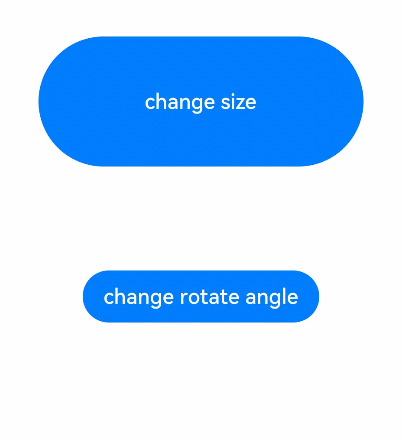harmony 鸿蒙Explicit Animation
Explicit Animation
With animateTo, you can build explicit animations for state changes caused by closure code. In an explicit animation that involves width and height changes, as in a property animation, a component’s content (such as text, canvas content, and linear gradient) is changed straight to the final state. To enable the content to change with the width and height during the animation process, you can use the renderFit attribute.
NOTE
The APIs of this module are supported since API version 7. Updates will be marked with a superscript to indicate their earliest API version.
The functionality of this module depends on UI context. This means that the APIs of this module cannot be used where the UI context is unclear. For details, see UIContext.
Since API version 10, you can use the animateTo API in UIContext to obtain the UI context.
animateTo(value: AnimateParam, event: () => void): void
Since API version 9, this API is supported in ArkTS widgets.
| Name | Type | Mandatory | Description |
|---|---|---|---|
| value | AnimateParam | Yes | Animation settings. |
| event | () => void | Yes | Closure function that displays the dynamic effect. The system automatically inserts the transition animation if the status changes in the closure function. |
AnimateParam
| Name | Type | Description |
|---|---|---|
| duration | number | Animation duration, in ms. Default value: 1000 Since API version 9, this API is supported in ArkTS widgets. NOTE - The maximum animation duration on an ArkTS widget is 1000 ms. If the set value exceeds the limit, the value 1000 will be used. - A value less than 0 evaluates to the value 0. - Floating-point values will be rounded down to integers. For example, if the value set is 1.2, 1 will be used. |
| tempo | number | Animation playback speed. A larger value indicates faster animation playback, and a smaller value indicates slower animation playback. The value 0 means that there is no animation. Default value: 1.0 NOTE A value less than 0 evaluates to the value 1. |
| curve | Curve |ICurve |string | Animation curve. Default value: Curve.EaseInOut Since API version 9, this API is supported in ArkTS widgets. |
| delay | number | Delay of animation playback, in ms. By default, the playback is not delayed. Default value: 0 NOTE - A value greater than 0 means to begin the animation after the specified amount of time has elapsed. A value less than 0 means to begin the animation in advance. If the absolute value of delay is less than the actual animation duration, the animation starts its first frame from the state at the absolute value. If the absolute value of delay is greater than or equal to the actual animation duration, the animation starts its first frame from the end state. The actual animation duration is equal to the duration of a single animation multiplied by the number of animation playback times. - Floating-point values will be rounded down to integers. For example, if the value set is 1.2, 1 will be used. |
| iterations | number | Number of times that the animation is played. By default, the animation is played once. The value -1 indicates that the animation is played for an unlimited number of times. Default value: 1 |
| playMode | PlayMode | Animation playback mode. By default, the animation is played from the beginning after the playback is complete. Default value: PlayMode.Normal Since API version 9, this API is supported in ArkTS widgets. For details about the restrictions, see Notes about PlayMode. |
| onFinish | () => void | Callback invoked when the animation playback is complete. Since API version 9, this API is supported in ArkTS widgets. |
Notes about PlayMode: - PlayMode.Normal and PlayMode.Alternate are recommended. Under these settings, the first round of the animation is played forwards. If PlayMode.Reverse or PlayMode.AlternateReverse is used, the first round of the animation is played backwards. In this case, the animation jumps to the end state and then starts from there. - When using PlayMode.Alternate or PlayMode.AlternateReverse, make sure the final state of the animation is the same as the value of the state variable. In other words, make sure the last round of the animation is played forwards. When PlayMode.Alternate is used, iterations must be set to an odd number. When PlayMode.AlternateReverse is used, iterations must be set to an even number. - PlayMode.Reverse is not recommended. Under this setting, the animation jumps to the end state at the beginning, and its final state will be different from the value of the state variable.
Example
// xxx.ets
@Entry
@Component
struct AnimateToExample {
@State widthSize: number = 250
@State heightSize: number = 100
@State rotateAngle: number = 0
private flag: boolean = true
build() {
Column() {
Button('change size')
.width(this.widthSize)
.height(this.heightSize)
.margin(30)
.onClick(() => {
if (this.flag) {
animateTo({
duration: 2000,
curve: Curve.EaseOut,
iterations: 3,
playMode: PlayMode.Normal,
onFinish: () => {
console.info('play end')
}
}, () => {
this.widthSize = 150
this.heightSize = 60
})
} else {
animateTo({}, () => {
this.widthSize = 250
this.heightSize = 100
})
}
this.flag = !this.flag
})
Button('change rotate angle')
.margin(50)
.rotate({ x: 0, y: 0, z: 1, angle: this.rotateAngle })
.onClick(() => {
animateTo({
duration: 1200,
curve: Curve.Friction,
delay: 500,
iterations: -1, // The value -1 indicates that the animation is played for an unlimited number of times.
playMode: PlayMode.Alternate,
onFinish: () => {
console.info('play end')
}
}, () => {
this.rotateAngle = 90
})
})
}.width('100%').margin({ top: 5 })
}
}

你可能感兴趣的鸿蒙文章
harmony 鸿蒙ArkTS-based Declarative Development Paradigm
- 所属分类: 后端技术
- 本文标签:
热门推荐
-
2、 - 优质文章
-
3、 gate.io
-
8、 golang
-
9、 openharmony
-
10、 Vue中input框自动聚焦